2023-03-22
Each morning we are a few people in the Netherlands, UK and Sweden having QSOs with New Zealand on 60m over long path. Almost always with FT8. Below are graphs of the SNRs at both ends for two days in March.
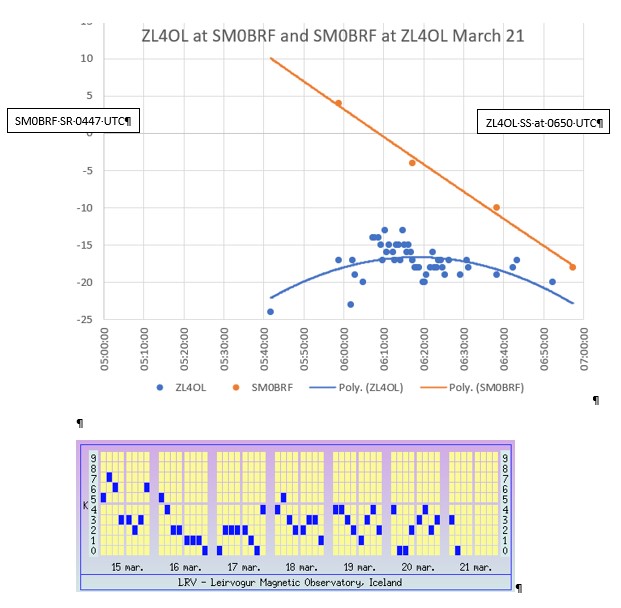
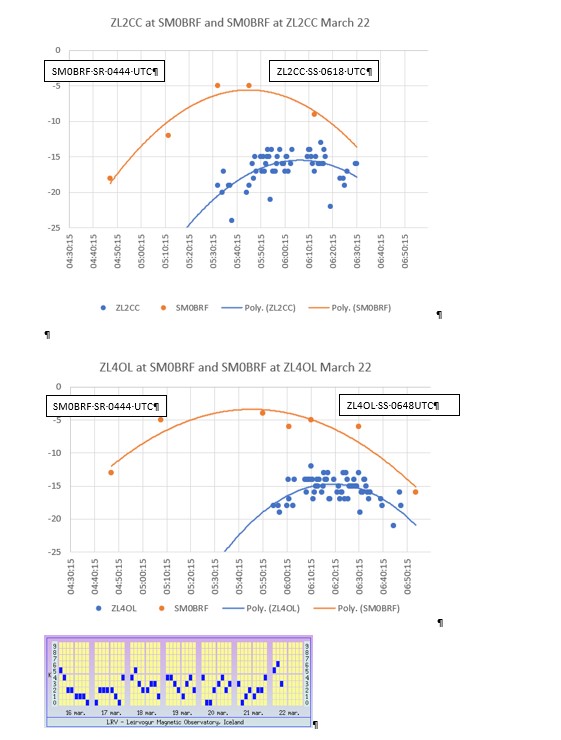
2022-12-27
The HAARP transmiiter in Alaska was activated today trying to probe the interior of an asteroid:
The transmission was recored by me on my RSPduo with SDRPlay SDRuno and on my IC-735. I was using my dipole for 30m broadside to KL7. The signal was S9 which corresponds to a field strength of 2.4 uV/m.
The signal detected on the IC-735 set to lower sideband at 9595 kHz to avoid a chinese AM transmitter at 9600 kHz:
As seen on SDRuno:
2022-01-23
Today we had a power failure and I took the opportunity to measure the local noise when there is no electric power at the neighbours.
2022-01-15
Last night when in contact with old friend LW8DRU in Buenos Aires on the 40m band there was severe Aurora which greatly affected the signals.
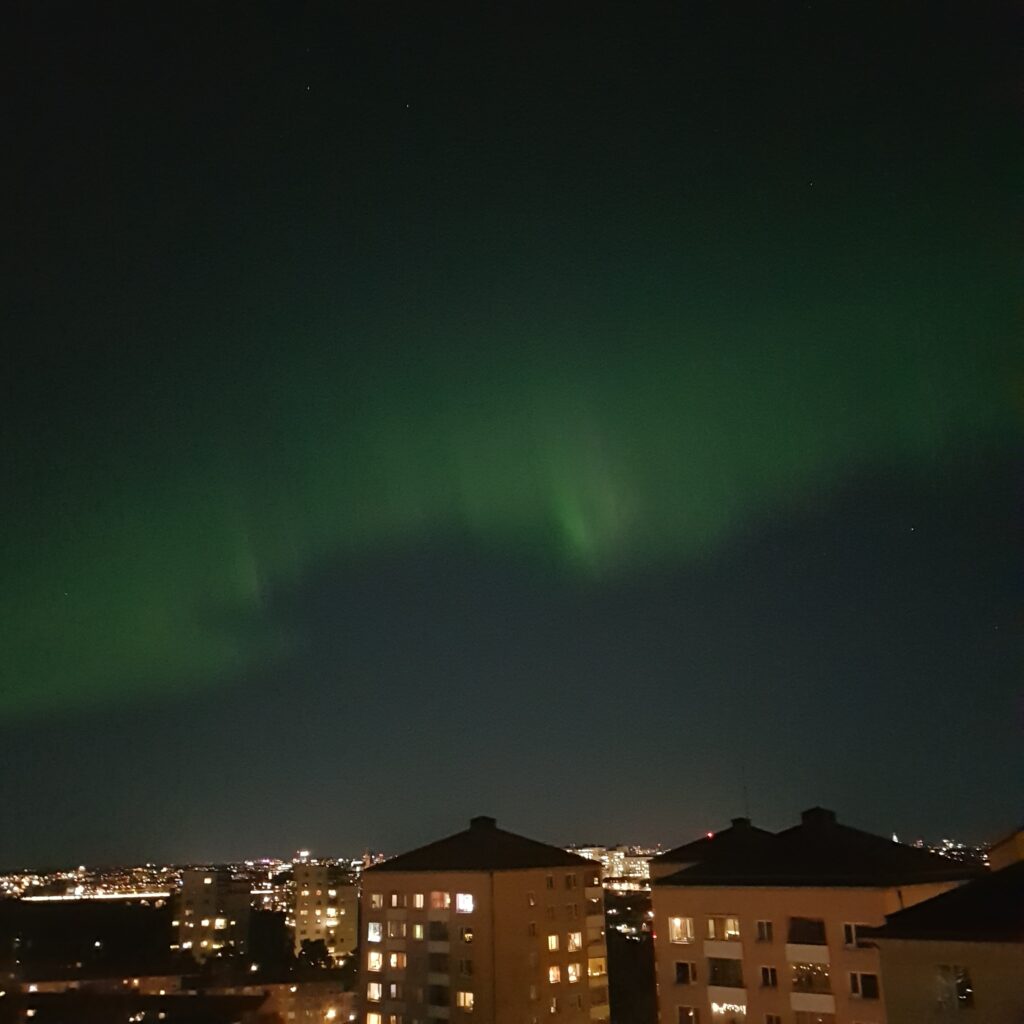
2021-05-21
Yesterday 6 m was very good with strong signals. So I tried to start my FT-817 on FT8. It worked if I did not use CAT control, but I did not get any contact between the radio and the computer for control. After many hours I tried to choose FT-857 in WSJT-X program instead and now it started. But now 6 m was no longer open ☹.
2021-03-14
Worked ZL1ALA this morning on 40m LP. Angle of arrival was 20 degrees.
2021-03-04
Good propagation in the evening. Short sound clip from 80 SP QSO:
2021-03-03
Last night there was a severe magnetic storm. In the morning bands were empty. Local signals still had aurora flutter. Only DX on 40 was ZL3XDJ with a good S7 signal and I received a 589 report.
His angle of arrival was 29 degrees.
2021-02-24
This morning I had a QSO with Brian, ZL3XDJ on 40m LP.
His signal arrived at angle of approximately 27 degrees above the horizon.
2021-02-16
Further tests of SDRs can be found here
2021-02-01
More on RSPduo sensitivity
Late last night when I called CQ on 30m I was called by 9L1YXJ in Sierra Leone. I listened to RSPduo with SDRuno, but could not perceive the callsign despite the narrowest possible filter. When I instead listened to my IC-735, it was no problem to read him. I estimate that he would have needed to increase the power by about 3-5 dB to be readable in SDRuno.
The settings were full RF Gain and automatic IF AGC. The antenna signal was fed through a 3 dB splitter.
2021-01-20
RSPduo sensitivity
I’ve noticed problems hearing very weak CW signals with the SDR compared to my old IC-735 that I have been using for twenty years. When the signal drops into the noise there is a big difference between the ICOM and the SDR. It seems like the noise at the ICOM is white while SDR has sort of ”cracking” noise making it impossible to read very weak CW signals. That puzzels me since the specifications of the RSPduo says the sensitivity is 0.14uV 12 dB SINAD with CW/SSB and the IC-735 specification says 0.15 uV 10 dB SNR. So they should be equal at detecting weak CW signals.
I’ve made a few simple measurements:
All measurements are made on Tuner 1 in SSB mode and 1800 Hz BW late in the evening .
80m
50 ohm connected to the antenna input: Noise = -127 dBm
Dipole: Noise -99 dBm
That is a room of 28 dBs between receiver noise and antenna signal.
40m
RF gain had to be reduced not to overload the ADC.
No antenna: -118 dBm
Dipole: – 104 dBm
A room of 14 dBs for the antenna signal.
10m
No antenna: -124 dBm
A 4 el Yagi and band closed: – 123 dBm
No room for the antenna signal.
I then connected my IC-735. The difference in noise between no antenna and the Yagi was measured to 18 dBs. There was a very notisible difference in the loudspeaker.
2020-12-28
ZL2GD worked on 80m CW at around 08Z. First ZL for ages on that band and mode. Later ZL2OK was worked with FT8.
2020-11-01
Today Ian, ZL2AIM was worked on 40m CW. The Azimuth angle was measured to about 230 degrees and the elevation angle was around 25 degrees.
JJ1VEZ, Mac was worked on 30m CW. He was using a 3 el Yagi and beamed Long Path. Reports were 599/599. Very good propagation.
2020-10-28
This morning ZL2CC, Mike was worked on 80m LP with FT8. Reports were -12/-12 dBs. No chance to measure the elevation angle on the crowded FT8 segment.
I went to 40 CW and listened to ZL3XDJ. He was coming in with S5 on the meter and the elevation angle was measured to be 20 to 25 degrees. The band was down 20 dBs from top performance on the path due to an earlier event.
2020-10-24
Last ZL on the screen was Mike ZL4OL at 0740.45Z with -17 dBs. SM7DLK just some 500 km away was -13 around that time. Amazing!
I’ve been updating my Direction Finding system lately especially meant for ZL on 60m. I’ve extended the baseline to 45 meters and placed it deeper into the woods to escape local QRM. I’ve been waiting for those booming signals we had last season. The suspicion was they came down at a very steep angle since I couldn’t get any bearing using a magnetic loop. That was the whole reason for the effort with the DF system.
As a last effort I made measurements on the ZL signals today even if they never got very strong.
The signals from ZL4OL and ZL2LW peaked around 0700 Z at about -6 dBs. But that was on the Beverage. The traces on the DF system was very weak at the time. They were going down all the time from around 0600Z. The reason probably is due to lower signal levels but decreased atmospheric noise and still rather high local noise which the DF verticals pick up but not the Beverage.
I measured the signals from ZL2CC, ZL4OL, ZL2AO and ZL2LW. According to the DF system they all had a vertical angle of between 30 and 35 degrees. That’s quite high. The signals from the Netherlands came at an angle of 23 degrees.
2020-10-23
This morning I was reached by the sad news that the radio amateurs in New Zealand will not get an extended permit to use the 60 meter band. They have had a temporary permit which has been extended several times. But now the military says no to another extension.
We are a few people in Sweden who have had daily contacts with amateurs in New Zealand. And my direction finding equipment was installed mainly to measure the radiation angle for signals from ZL on 60 m.
2020-10-18
Extended antenna system
Today another antenna element was put in service, antenna number 4 in the DF system. It is placed about 42 meters in 245 degree direction from antenna element 3. It consists of a 10 meter long vertical with five 10 meter long counterweights on the ground and a ground rod. The idea is to get a long leg in a southwesterly direction to be able to measure the vertical radiation angle more accurately for signals coming close from SW or NE. Antenna number 3 today has the lowest interference level and is furthest from the large antenna mast.
Antenna 4 is fed with about 63 meters RG-6 with a velocity factor of 0.66. The other antennas are fed with equally long RG-213 cables of about 40 meters.
To calibrate the difference in cable length, a measurement transmitter was placed about 200 meters away perpendicular to the midpoint of the connection line between antenna 3 and 4. The frequency was 3505 kHz and the phase difference between the channels in RSPduo was measured to 154 degrees which is the difference in electrical length for the feeders of antenna 3 and antenna 4 at 3505 kHz.
2020-10-12
Today I measured the azimuth and elevation angles of the 60m FT8 signals from PA2S.
Azimuth measured to 210 dgs. Should be 225 dgs.
Elevation angle 37 dgs. HamCap says 32 dgs.
The goal was to make a measurement on ZL signals since they were good but QSB started to make the numbers erratic.
2020-10-10
This morning I made a comparison between RX antennas on 60m LP to New Zealand. The station was ZL4OL on FT8:
North West Beverage (190m) -10 dB
South West Beverage (185m) -14 dB
Rotatable dipole for 40m at 21m -10 dB
10m vertical in DF system -16 dB
MiniWhip active antenna 4m up and 40m into the woods No decode.
2020-09-21
My DF system with three 10 m verticals has now been running for some time. ZLs are worked every morning on 60m FT8 via long path. Signals are still too weak to get a reliable reading of the azimuth and vertical angles.
Today I listened on 60m using my 40m full size rotary dipole and could get a bearing on ZL4OL. He was coming over a true Great circle path at 250 degrees (LP).
2020-04-18
Last night I worked CX5FK / QRP on 20 m. Today an e-mail came with a link to his Youtube channel. https://www.youtube.com/watch?v=oBBTnb6HcHE
I had bad QRN from thunderstorms over Spain one hop away.
2020-04-12
I have now tried my purchased SDRPlay RSPduo.
The first test on 7 MHz with two passive 2-meter loops gave an improvement of SNR of about 10 dB if I used diversity. They are 10 m apart along the loop plane.The phase angle fluctuates violently. Don’t know what it indicates.
Later I tested my 30 m dipole against other antennas in manual mode to see if local interference could be removed. If I used the 60 m vertical as antenna two, I could remove a pretty strong interference, but I think it was induced in the vertical.
2020-04-02
Today I started to design a passive magnetic loop with a diameter of 2 meters. After a bit of googling, I found that it required such a large loop to get a high efficiency of 7 MHz where it is thought that the measurements of the radiation angle should be done in the first place.
http://www.66pacific.com/calculators/small-transmitting-loop-antenna-calculator.aspx
May be needed if measuring weak DXX signals.
Thought to use coax stumps as a capacitor inspired by DJ0IP och VK3YE
https://www.dj0ip.de/my-favorite-antennas/old-folks-antenna/ .
https://www.youtube.com/watch?v=Cv_RnLpZ9gw
According to KB9RLW, a small change in the coupling loop can give a big improvement:
https://www.youtube.com/watch?v=2RDtm6qXjuI
The loop: 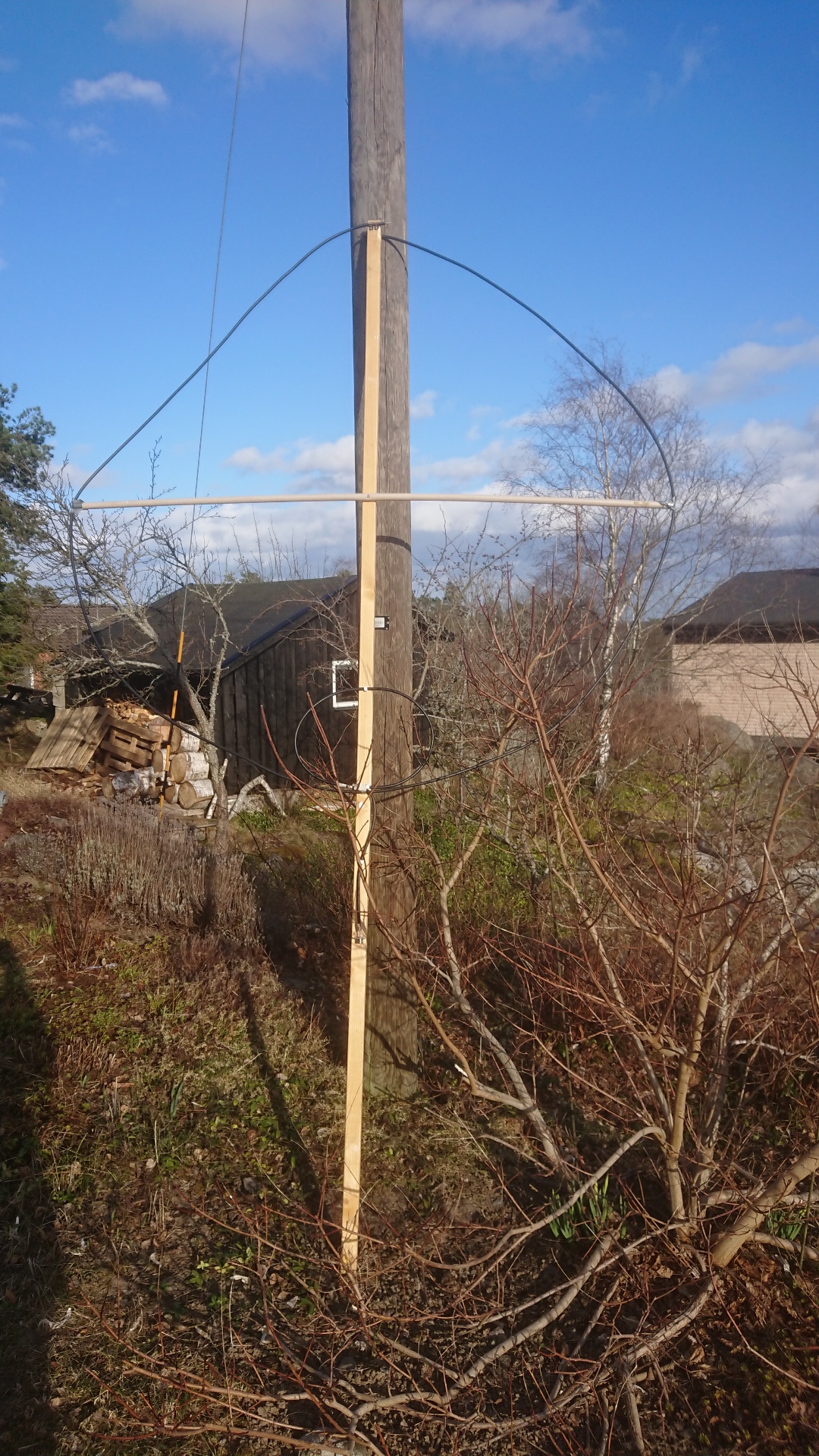
To measure it, a capacitor of 110 pF was connected and the resonance was measured with a MiniVNA: 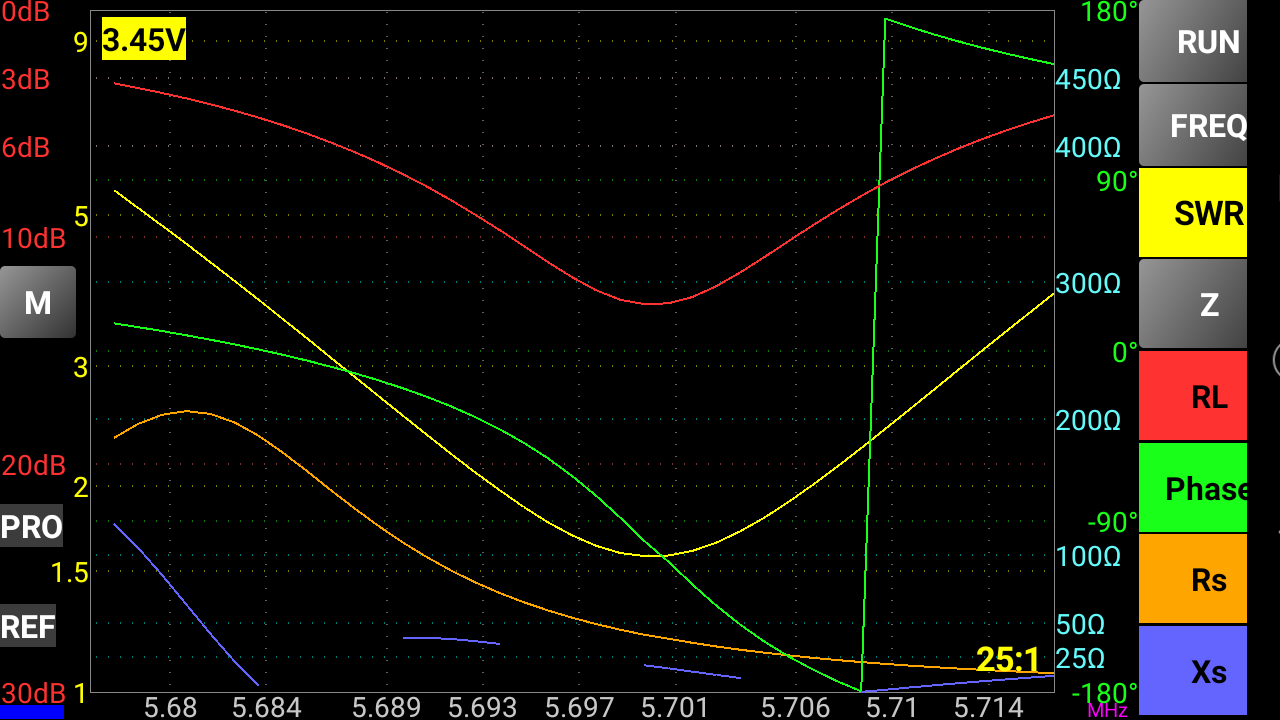
The resonant frequency was 5.7 MHz. Usable bandwidth is about 0.25%. If the loop capacitance is ignored, a capacitance of 74 pF must be used for the resonance at 7 MHz.
The self-capacitance seems to be just under 9 pF according to:
https://www.teslascientific.com/products/coil-capacitance-calculator/
In this case, the inductance of the loop is about 6.6 uH. For a 7 MHz resonance, the total capacitance should then be 79 pF. Thus, if the self-capacitance is subtracted, the external capacitor must have a capacitance of 70 pF.
2020-03-30
This morning I tried the new vertical for reception on 60 and 40 meters.
At 60 m I got no decoding on FT8 of any ZL station. They had an SNR of up to – 10 dB on my northwest Beverage. They were – 18 dB on my TX vertical. However, Europeans had the same SNR on the receive vertical as on the Beverage. For example, PG0DX was +17 dB on both antennas. It is below a certain threshold in signal strength, where it becomes critical.
At 40 m I had contact with LU8HHB. He was well readable at S5 on my rotatable dipole which is 21 meters up. You could hear he was there when I listened on the receive vertical, but he was unreadable.
I later listened to weak stations on 80m. There were stations which were perfectly readable on my inv vee dipole but not heard at all on the the receive vertical.
It appears that a small receive antenna will not be sensitive enough for weak signals if it is broadband. There is too much noise in the connected broadband amplifier no matter how good it is. A tuned loop, on the other hand, has sufficiently low noise if it has a high Q value.
https://www.lz1aq.signacor.com/docs/wsml/wideband-active-sm-loop-antenna.htm
2020-03-29
Today I put out a vertical antenna for reception in the forest. It consists of a vertical radiator and two raised counterweights. All wires are 3 meters long. It is connected to the same broadband amplifier used for the loop previously.
It seems to work OK for European signals on 160 to 20 meters. However, when compared to my 3 element Yagi at 22 meters on 14 MHz, the signals were down almost 30 dB.
2020-03-26
This morning I tested the passive loop at 7 MHz. It worked well for receiving weak signals provided it was precisely tuned. A useful frequency range is only +/- 10 kHz for best SNR on received signal.
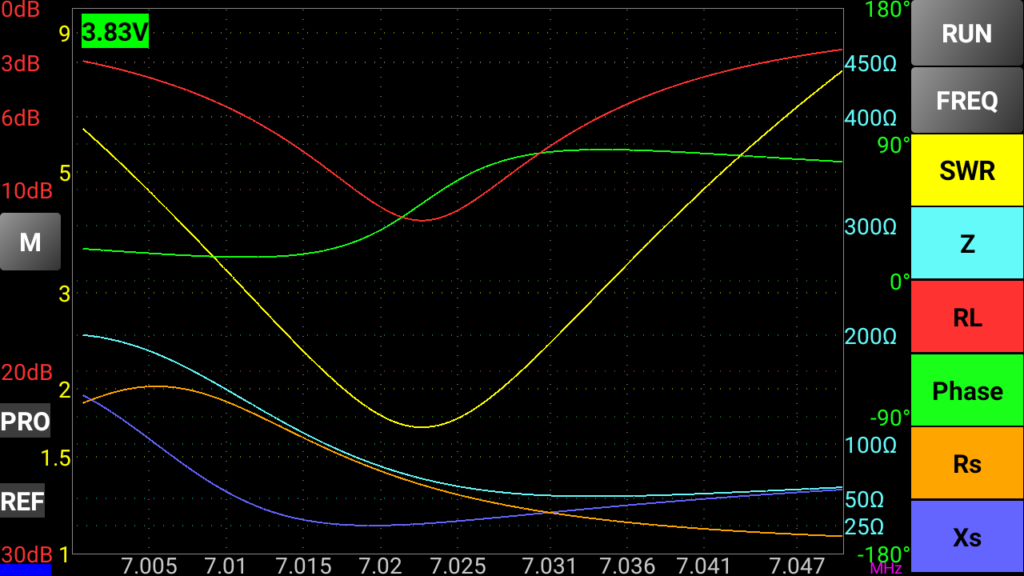
The pickup loop with connecting coax consists of 75 ohms TV coax. Hence the high SWR at resonance as the analyzer measures at 50 ohms.
The loop was tuned in the evening, but had moved 50 kHz during the night. The cause is unknown. Maybe the frequency drives with the temperature. In any case, it shows that it should be possible to tune the remote in final set up.
2020-03-25
Tried the active loop again today. I wanted to see how it worked at 7 MHz for weak signals. I first measured that the noise increased 7 dB when the antenna loop was connected. So it seemed hopeful. Unfortunately, it did not work at all for weak signal reception. Could it possibly be “cross modulation” that is heard as a noise and drowns weak signals?
I worked among others ZL3XDJ. There were poor conditions, but he was well copied on the dipole at 21 meters and the NW Beverage. He was an estimated 10 dBs over the noise. However, not audible on the loop.
2020-03-24
This morning I tried the passive loop again. Now without glitch in the rotary capacitor. Unfortunately, they were the same results as last time. Typical signals from ZL on 60m FT8 were -7 dB on the NW Beverage, -11 dB on the SW Bev and -14 dB on the passive loop. There is a rattle of 100 Hz at the bottom of the signal on all the antennas.
2020-03-23
Checked the passive loop against ZL on 60m this morning.
The best signal was as usual on the NW Beverage. The SW Bev was 3 dB inferior and the loop was 7 dB inferior to the NW Bev. But it was very low output from the loop. I went out later and checked with my FT817. There was obviously transitional resistance in the variable capacitor, so I had to rotate it a bit back and forth and then I got a resonance and a sharp increase in noise.
Later checked against a weak Frenchman who was around -15 dB. Then the SW Bev was the best, but the loop was only 1 dB worse. The NW Bev was 8 dB inferior to the SW Bev.
Will check again tomorrow against ZL after spraying the capacitor.
The noise from the active loop was measured with and without the loop (shorted). The measurements showed that the atmospheric noise was 7 dB stronger than the amplifier noise at 1700 CET on 23 March.
One hour before sunset.
2020-03-22
As part of my project to measure the incidence angle of incoming radio waves for DX at low frequencies, I tried an active loop at 5 MHZ FT8 for ZL over long path. The loop was about 50 meters into the forest. Unfortunately, the loop turned out to be too noisy. I had to switch to a Beverage as the receiving antenna.
The amplifier was made according to a scheme found online https://www.pa1m.nl/simple-active-receive-loop/. I had replaced the transistors with the switch transistors 2N3019, which I had in the junk box. It may not have been optimal.
I have now replaced the active loop with a passive tuned loop. It seems to work better and does not have the same noise. When listening to XV1X he was about 4 dB better on my 130 meter long NE Bev when around -20 dBs. When the signal reached 0 dB there was no difference between the antennas. Will see how it works for ZL LP.
2019-12-26
This morning the propagation on 160 and 80 was extreme.
One QSO was with N5CM in LA on 80m CW. At my sunrise he was S9 on my dipole and he was using 100W to a horisontal loop 18 m high. At first, I was using my Inverted Vee dipole facing NW/SE which normally is best for NA. But later I found the Inv Vee dipole facing SW/NE was 1-2 S-units better!
2019-12-14
Recording from 160 m using the new 190 bev. Starting with RX connected to the bev. I’m keying “bev” in CW. Then switching to the TX antenna while I’m keying “vert” and then back to the bev. The station recorded is WU1ITU. No detectable signal when listening on the tower:
2019-12-10
The NW Beverage is now extended to 190 meters and terminated. The performance on 160m is excellent.
2019-10-20
VP6R, Pitcairn Island on 80m CW. In the log around 0600 UTC with my simple Inverted Vee dipole.
2019-08-30
A new 60m season just started. ZL4OL on FT8 despite poor propagation on higher bands.
2019-08-24
What can be achieved with an indoor magnetic loop?
The other day, when I was calling CQ on 20m beaming NW I heard a weak signal replying. I could only get odd characters through. After next CQ though the signal had raised out of the noise. It was Hugh, VA7UNX who was calling and he now had QROed from 5 to 15W. He was using a K2 and a homebrew magnetic loop inside his second floor flat leaning towards a bookshelf! The attached picture shows the antenna in operating position.
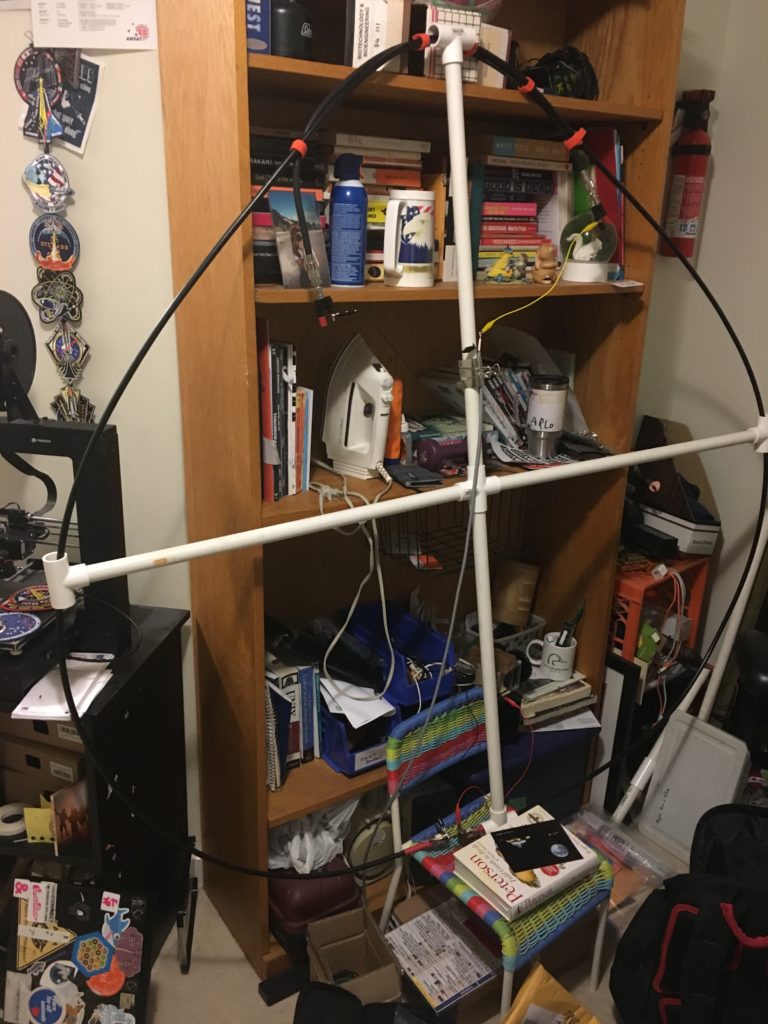
2019-07-16
My radiator on my tribander is now modified with separate dipoles for 20, 15 and 10m with the dipoles for 10 and 15 horisontally strung between a center support and a 50 cm long vertical spacers about 4 m from the center.
Two years ago the dipoles were strung from the center support towards the end of the 20m dipole but this was no good. he ends were close to the 20m dipole affecting the resonant point greatly when moved in the wind.
2019-04-10
Today ZL4OL was worked on FT8 and CW on 60m. Mike was about -15 dBs as reported by the FT8 software. So CW workes fine at least down to -15 dBs.
2019-04-07
60 m is an amazing band. Open to ZL long path every morning. But one thing has puzzled me: ZLs has always had a better SNR by 3 dBs on my NW 110 m long unterminated beverage compared to my 185 m long WSW terminated beverage. One can argue it might be due to higher noise on that one but the NW bev sounds noisier. And stations in Europe in the SW direction are definitely much better on the WSW bev.
So this morning I ran out into the woods with my FT-817 and a mag loop to find out. I didn’t bring a laptop and accessories but just listened to the carrier from ZL4OL. And I couldn’t find any bearing. The signal seemed to come from any direction! To me it means the signal came down at a very steep angle. The Europeans on the other hand could be pinpointed in their true directions.
2019-01-20
Today I got the small FT-817nd running on FT-8 using the DigiMaster
MiniProSC external soundcard and the dongle Yaesu CT62 CAT Interface. All from http://www.g4zlp.co.uk/ .
It was necessary to change the default LSB to USB in DIG mode on the rig.
So now I’m prepaired for next vacation trip.
By the way the old free HRD SW was awesome in conjuction with the FT-817. No menue struggle, just click on a button and BIG digits and a large S-meter bar.
2019-01-06
Tried PSK Reporter for FT8. What an excellent tool to find out where to the band is open: PSK Reporter
2019-01-02
Northerly storm during the night. Antennas seem to have survived but the 40m dipole had twisted 90 dgs around the mast.
It was parallell to the tribander boom not to affect the performance of the beam. But now parallell to the radiator of the beam. SWR improved to 1:1 on the dipole but resonance is on 7180 kHz.
